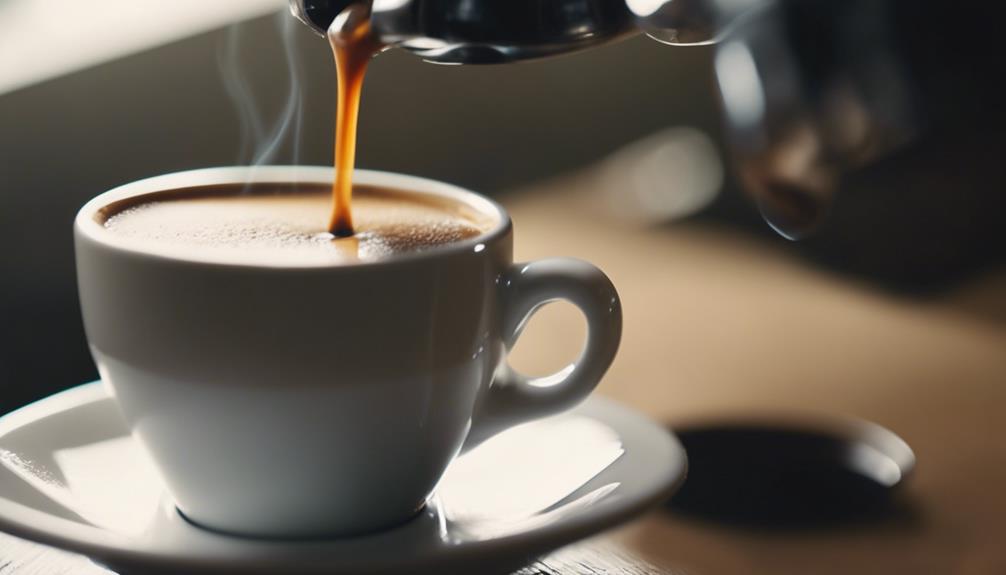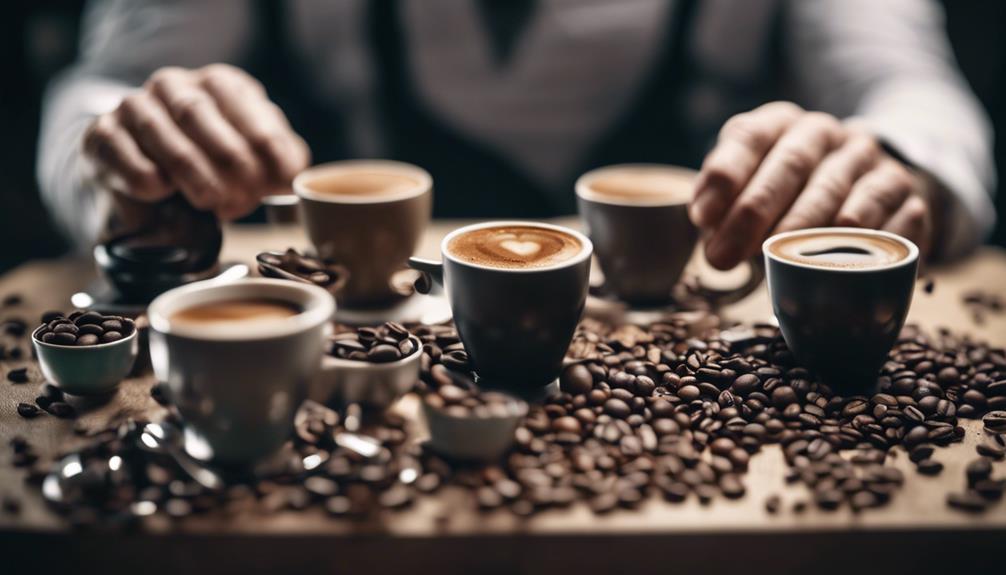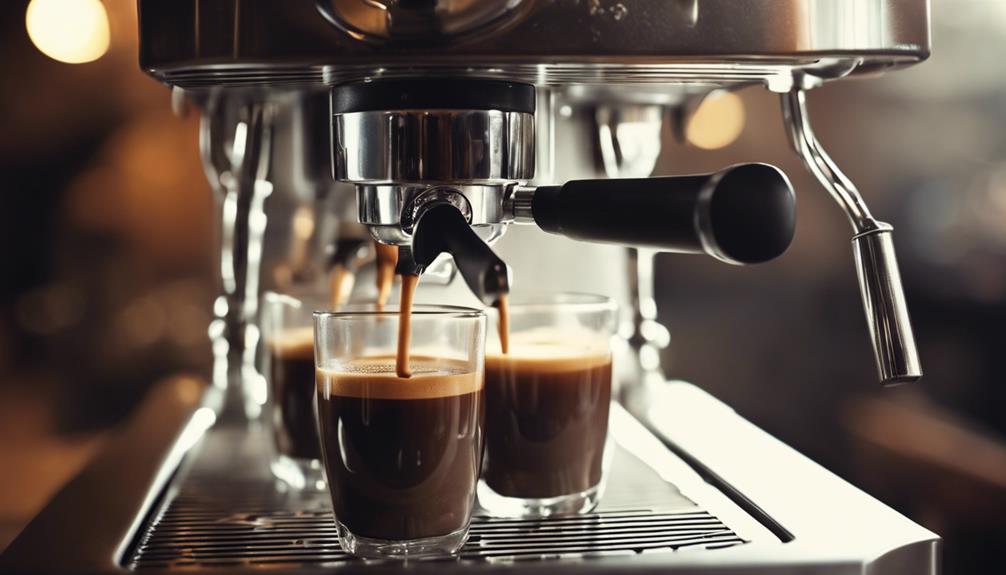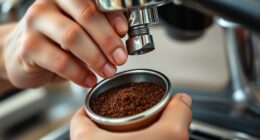It is recommended by health experts that you should limit your daily espresso intake to around 6 shots or fewer cups. Excessive caffeine consumption can have negative effects on your health, so it is important to practice moderation. Various factors such as weight, genetics, and medications can influence your caffeine tolerance. Be mindful of symptoms like jitteriness, headaches, or insomnia, as they may indicate sensitivity or overconsumption. It is crucial to prioritize healthy sleep patterns and heart health. Stay within safe limits, adjust your intake according to your body’s signals, and consult a healthcare professional for personalized advice. Always remember that your health should be a priority when enjoying your espresso.
Key Takeaways
- Limit espresso intake to 6 shots or below 4 cups per day.
- Excessive amounts pose health risks like insomnia and anxiety.
- Consult healthcare professionals for personalized advice.
- Monitor symptoms like jitteriness to adjust intake.
- Stay within safe limits for potential health benefits.
Daily Espresso Intake Recommendations
Limit your daily espresso intake to no more than 6 shots to stay within recommended guidelines. Consuming more than this amount can lead to exceeding safe limits of caffeine intake, potentially causing adverse effects on your health.
Health experts advise keeping your espresso consumption below 4 cups per day to avoid overloading your system with caffeine. It's crucial to be mindful of the amount of caffeine you consume, as exceeding the recommended daily intake can have serious consequences, with excessive amounts such as 156 shots in a day posing lethal risks.
To enjoy the potential health benefits of espresso, such as improved focus and alertness, it's essential to moderate your intake and keep your caffeine concentration in the blood below 15 mg/L. By staying within the safe limits of espresso consumption, you can savor your favorite brew without compromising your well-being.
Understanding Caffeine Tolerance Levels

To gain a better insight into how your body responds to caffeine, it's essential to consider the various factors that influence your individual caffeine tolerance levels. Factors such as weight, genetics, sensitivity, age, gender, and medication use can all play a role in determining how much caffeine your body can handle.
Monitoring how your body reacts to caffeine can help you understand your personal tolerance level. It's noteworthy that excessive consumption of caffeine can lead to negative health effects, regardless of your tolerance levels.
If you're concerned about your espresso intake and caffeine tolerance, it's advisable to consult a healthcare professional for guidance. They can provide personalized recommendations and help you navigate the complexities of caffeine tolerance levels to ensure you're consuming espresso in a way that supports your overall health and well-being.
Potential Health Risks of Excessive Consumption

Excessive consumption of espresso can pose various health risks that you should be aware of. It can impact your sleep patterns, leading to restlessness and insomnia, affecting your overall well-being.
Additionally, overindulging in espresso may have adverse effects on your heart health, potentially increasing the risk of heart problems. Monitoring your espresso intake is essential to prevent these negative consequences and maintain a healthy lifestyle.
Health Risks Overview
Overindulging in espresso can lead to increased anxiety levels and mimic symptoms of anxiety disorders. Excessive espresso consumption can disrupt your sleep patterns, potentially leading to insomnia. It can also elevate your heart rate and blood pressure, posing risks to your cardiovascular health. Digestive issues such as acid reflux and upset stomach may arise from consuming too much espresso. Additionally, dependency on caffeine from overconsumption of espresso can result in withdrawal symptoms and other health risks.
| Health Risks of Excessive Espresso Consumption | |
|---|---|
| Increased anxiety levels and mimic symptoms of anxiety disorders | Disrupted sleep patterns and insomnia |
| Elevated heart rate and blood pressure, impacting cardiovascular health | Digestive issues like acid reflux and upset stomach |
| Dependency on caffeine leading to withdrawal symptoms and potential health risks |
Impact on Sleep
Consuming an excessive amount of espresso can greatly disrupt your sleep patterns due to its high caffeine content, potentially affecting your overall well-being. The high caffeine levels in espresso can lead to an increase in heart rate and blood pressure, making it challenging to achieve restful sleep.
This disruption in sleep patterns can have a significant impact on the overall quality of your sleep, leaving you feeling fatigued and irritable during the day. In addition to sleep disturbances, excessive consumption of espresso can also result in digestive issues, further complicating your well-being.
Moreover, a dependency on caffeine from consuming too much espresso can develop, leading to difficulty falling asleep even when you want to rest. This cycle can perpetuate sleep problems and affect your daily functioning.
It's important to be mindful of your espresso intake to maintain a healthy sleep routine and overall well-being.
Heart Health Concerns
Prolonged intake of high levels of espresso may pose significant risks to your heart health, potentially leading to adverse effects on your cardiovascular system. Excessive consumption of espresso has been linked to elevated heart rate and high blood pressure, increasing the likelihood of experiencing heart palpitations and irregular heartbeats.
These effects can contribute to the development of cardiovascular issues over time, emphasizing the importance of maintaining a balance in your espresso intake. Regularly surpassing the recommended intake of espresso can negatively impact your heart health, underscoring the necessity for monitoring consumption levels.
To safeguard your heart health, it's essential to be mindful of how much espresso you consume daily and to contemplate potential risks associated with excessive caffeine consumption. By being aware of these concerns and moderating your espresso intake, you can help reduce the likelihood of experiencing adverse effects on your cardiovascular system.
Monitoring Your Espresso Consumption
Keep track of how much espresso you're drinking to guarantee you stay within safe caffeine limits. To avoid negative health effects, it's important to monitor your espresso consumption.
The recommended daily intake of espresso is set at 2-3 shots, with a maximum limit of 6 shots per day to stay within safe caffeine limits. Excessive espresso intake, such as consuming 156 shots in a day, can be fatal due to caffeine overdose.
Moderation is essential when it comes to enjoying espresso. By monitoring your caffeine intake and being aware of your body's response to caffeine, you can adjust your espresso consumption accordingly to maintain a healthy balance.
Pay attention to any signs of discomfort or adverse effects, and consider cutting back if needed. Remember, it's vital to be mindful of your espresso intake to prevent any potential health risks associated with excessive caffeine consumption.
Factors Affecting Individual Caffeine Sensitivity

To determine the appropriate amount of espresso for your daily consumption, consider the various factors that influence individual caffeine sensitivity. Caffeine sensitivity isn't a pivotal situation; it's influenced by a variety of individual factors such as genetics, metabolism, and caffeine tolerance.
Genetics play a role in how your body processes caffeine, with some individuals metabolizing it more slowly, leading to heightened sensitivity and potential adverse effects. Additionally, age, weight, and overall health status can impact how your body reacts to caffeine from espresso.
Additionally, external factors like medications, hormonal fluctuations, and stress levels can also affect your caffeine sensitivity. Understanding your own caffeine tolerance is important in determining the safe amount of espresso you can consume in a day.
Signs of Overconsumption to Watch For

If you start feeling jittery, restless, or notice your heart racing after drinking espresso, you might be having too much.
Other signs like anxiety, trouble sleeping, or digestive discomfort can also signal overconsumption.
Keep an eye out for headaches, dizziness, or rapid breathing as potential indicators that you've exceeded your daily espresso intake.
Warning Signs of Excess
Excessive consumption of espresso can manifest through evident signs such as jitteriness, restlessness, and a rapid heartbeat. Since caffeine is a stimulant, drinking too much espresso can lead to these warning signs of excess.
Pay attention to side effects like anxiety, insomnia, and digestive issues after indulging in a caffeine boost. It's crucial to listen to your body and recognize when you may be exceeding your limits.
If you start experiencing physical symptoms such as dizziness, increased body temperature, or irregular bowel movements, it might be a sign that you need to cut back on your espresso intake. More severe symptoms like palpitations, chest pain, or excessive sweating shouldn't be ignored, and seeking medical attention is recommended.
To avoid health risks associated with overconsumption, it's essential to set boundaries and limit your espresso intake to stay within safe caffeine consumption levels.
Health Risks to Note
Consuming high amounts of espresso can result in noticeable signs of overconsumption, including jitteriness and increased heart rate. It's important to be mindful of the health risks associated with excessive intake of espresso. Here are some effects and symptoms to monitor for:
| Health Risks | Signs and Symptoms | Adverse Effects |
|---|---|---|
| Anxiety | Jitteriness | Increased heart rate |
| Restlessness | Insomnia | Digestive issues |
| Dehydration | Increased blood pressure | Difficulty concentrating |
| Dependency on caffeine | Palpitations | Disrupted sleep patterns |
It's vital to pay attention to your body's response to espresso and watch out for these warning signs. Overconsumption can lead to various adverse effects on your health, such as anxiety, restlessness, and disruption of normal bodily functions. Keep track of how much espresso you're consuming to avoid these potential health risks and maintain a balanced intake for your well-being.
Balancing Espresso Enjoyment With Health

To maintain a healthy balance between your espresso enjoyment and well-being, it's essential to monitor your daily intake carefully. While espresso can be a flavorful pick-me-up, exceeding recommended limits can lead to health risks.
The ideal daily consumption should generally not exceed 6 shots, amounting to about 408mg of caffeine. Consuming excessively high amounts, like 156 shots in a day, can result in a lethal dose due to caffeine overdose.
To enjoy espresso safely, it's important to keep your caffeine concentration in the blood below 15 mg/L and be mindful of your caffeine tolerance. Understanding your body's response to caffeine can help you adjust your intake accordingly.
If you have concerns or want personalized advice, consulting a healthcare professional is recommended. They can provide insights tailored to your individual health status and help you determine a safe and enjoyable amount of espresso to consume daily.
Adjusting Espresso Intake Based on Symptoms

If you start experiencing symptoms like jitteriness, headaches, or insomnia, it's important to adjust your espresso intake accordingly. These signs could indicate that your body is sensitive to caffeine, and reducing your espresso consumption may help alleviate these issues.
Similarly, if you feel anxious, restless, or notice heart palpitations after drinking espresso, cutting back on your intake is advisable. It's vital to pay attention to your body's signals; if you start feeling overly stimulated, it may be a sign to decrease your espresso intake.
Moreover, digestive problems such as acid reflux or stomach discomfort can also be linked to excessive espresso consumption. If you experience these issues, consider lowering your intake of espresso.
Maintaining a Healthy Relationship With Espresso

Maintaining a healthy balance with espresso involves being mindful of your daily intake and understanding your body's response to caffeine. Here are some key points to help you maintain a healthy relationship with espresso:
- Espresso consumption: Limit your intake to no more than six shots per day to stay within healthy caffeine levels.
- Moderation: Excessive intake, such as 156 shots in a day, can have fatal consequences, so remember to enjoy espresso in moderation.
- Caffeine tolerance: Be aware of your body's tolerance to caffeine and adjust your espresso intake accordingly.
- Healthy intake levels: Stay within safe limits of 2-3 shots per day to enjoy a pleasurable espresso experience while avoiding negative health effects like anxiety or digestive issues.
Frequently Asked Questions
How Many Espresso Shots Can You Have a Day?
You can have a moderate intake of espresso, with the recommended limit of no more than 6 shots per day to avoid health risks.
Excessive consumption may lead to issues like anxiety and insomnia due to the high caffeine content in each shot, averaging around 68mg.
It's crucial to monitor your caffeine intake carefully to enjoy espresso responsibly and stay within safe limits to avoid potential negative effects on your well-being.
Is 4 Shots of Espresso a Lot?
Having 4 shots of espresso in a day falls within the safe caffeine limits for most adults. It contains around 272mg of caffeine, below the FDA's recommended daily cap of 400mg.
Factors like your caffeine sensitivity and tolerance play a role. While 4 shots can give a significant caffeine boost, monitor for any adverse effects like jitteriness.
Is 8 Oz of Espresso Too Much?
Having 8 oz of espresso is excessive, equivalent to 8 shots and exceeding the daily limit.
Stick to 2-3 shots to avoid health risks.
Moderation is key.
Is a Shot of Espresso a Day Good for You?
Having a shot of espresso daily can be beneficial for you. It offers antioxidants and potential health perks. With about 63-68mg of caffeine, it provides a boost without exceeding safe limits for most adults.
This moderate consumption can enhance mental alertness and focus. Pairing it with a balanced diet and staying hydrated can amplify its advantages.
What Are the Recommended Daily Limits for Espresso Consumption?
The recommended daily limit for safe espresso shot consumption is around 2 to 4 shots. Consuming more than this amount can lead to negative effects like increased heart rate, anxiety, and difficulty sleeping. It’s important to be mindful of your caffeine intake to avoid any potential health issues.
Conclusion
To sum up, remember that moderation is key when it comes to enjoying your daily espresso fix. Keep an eye on your caffeine intake, listen to your body's signals, and adjust accordingly. As the saying goes, 'all things in moderation.'
By staying mindful of your espresso consumption and being aware of your caffeine tolerance, you can continue to enjoy your favorite drink while also prioritizing your health and well-being.
Stay balanced and savor every sip responsibly.









